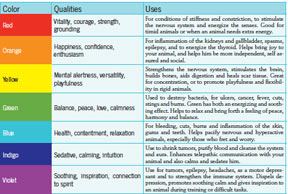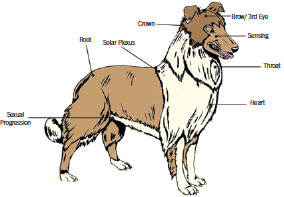Color therapy can have profound effects on our physical, emotional and even mental well being. The same applies to our dogs and cats.
Color therapy is an ancient healing art that originated in Egypt, and was commonly used in India and China. Much like crystal healing, it is based on the premise that a particular vibration or frequency draws forth or attracts to a being similarly resonating vibrations or frequencies.
Scientific data confirms that each color found in the light spectrum has its own measurable wavelength and vibrational frequency. This means, for instance, that the color purple vibrates at a different frequency or energy level than the color red. So each color carries its own unique healing properties
How does it work?
You may have heard that some animals, including dogs, don’t see color. While I disagree, color influences even those who can’t see it. That’s because it works primarily through the energy field, namely the chakras and subtle bodies.
The energy field of an animal is his nonphysical component and is made up of etheric, emotional, mental and spiritual bodies, also known as subtle bodies, as well as a chakra system. Chakras are energy portals or vortices.
Each chakra governs a specific area of the body including the surrounding organs, tissues and glands as well as related emotional, mental and spiritual concerns (see diagram below). Color therapy helps restore balance in the animal’s energy field, which in turn has a positive effect at the physical level.
 Specific colors or “vibrations of color” can be used to treat various conditions by promoting healing and balance in areas that the animal is struggling with, including physical, emotional, mental or spiritual issues. Ways to use color therapy
Specific colors or “vibrations of color” can be used to treat various conditions by promoting healing and balance in areas that the animal is struggling with, including physical, emotional, mental or spiritual issues. Ways to use color therapy
- Colored fabrics – bedding, blankets, clothing and collars.
- Colored silks – laid on the body during a healing session.
- Colored light – bathe your animal in light from a color-filtered light source. Simply place a colored light (or regular light with a theatrical color gel or transparency) in a comfy place where your animal can rest. Allow him to naturally gravitate to the area; instinct will guide him to what his body needs. It is crucial to not subject him to this treatment in a crate or cage where he cannot move away from it. Your animal will intuitively know if and when he has had enough. Do not shine colored lights directly into his eyes.
- Solarized drinking water – solarize water by simply surrounding a glass container of water with an appropriately colored theatrical gel and leaving it in the sunlight for a number of hours.
- Lasers or “colorpuncture” – uses concentrated colored light pens but requires training or professional knowledge.
- Color aura sprays – these are commercially available, but make sure ingredients are natural and animal-safe.
- Color elixirs – similar to flower essences and commercially available.
- Gemstones – use stones of the particular color that your animal companion needs.
- Candles – burn appropriately colored natural candles in a safe situation; use candles made from beeswax or soy/vegetable based waxes.
- Color baths – color packets can be found in most health food stores, but are not recommended for light colored animals. Make sure the product uses non-toxic color sources.
- Crystal or glass prisms – hang these in the windows of your animal’s living area.
When choosing a particular color (or colors) for your dog or cat, remember that you know him best. Follow your heart and intuition, and you can rarely go wrong.
 Animal chakras
Animal chakras
Root – red
Sexual progression – orange
Solar plexus – yellow
Heart – green
Throat – sky blue
Sensing – silver blue
Brow – indigo
Crown – purple
Note: Color therapy is not a replacement for veterinary care. One very simple way of using color therapy is to simply match the color to that of the chakra governing the issue at hand. If you’re not sure which color to use, simply choose the chakra closest to the ailment or condition you are treating. Also, for general well-being, you can treat each chakra with its associated color as a sort of energy “tune up”. This is particularly useful before a special event, or as a followup to a particular taxing one.







